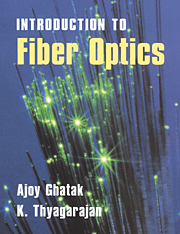Book contents
- Frontmatter
- Contents
- Preface
- Acknowledgments
- Abbreviations
- 1 Introduction: The fiber optics revolution
- 2 Basic optics
- 3 Basic characteristics of the optical fiber
- 4 Ray paths and pulse dispersion in planar optical waveguides
- 5 Pulse dispersion in graded index optical fibers
- 6 Material dispersion
- 7 Modes in planar waveguides
- 8 Propagation characteristics of a step index fiber
- 9 Propagation characteristics of graded index fibers
- 10 Waveguide dispersion and design considerations
- 11 Sources for optical fiber communication
- 12 Detectors for optical fiber communication
- 13 Design considerations of a fiber optic communication system
- 14 Optical fiber amplifiers
- 15 Dispersion compensation and chirping phenomenon
- 16 Optical solitons
- 17 Single-mode fiber optic components
- 18 Single-mode optical fiber sensors
- 19 Measurement methods in optical fibers: I
- 20 Measurement methods in optical fibers: II
- 21 Periodic interactions in waveguides
- 22 The ray equation in cartesian coordinates and its solutions
- 23 Ray paths and their classification in optical fibers
- 24 Leaky modes
- Appendix A Solution of the scalar wave equation for an infinite square law medium
- Appendix B The far-field pattern
- Appendix C WKB analysis of multimode fibers
- Appendix D Gaussian envelope approximation
- Appendix E Coupled-mode equations
- Appendix F Derivation of coupled-mode equation for periodic coupling
- Appendix G Leakage loss in optical waveguides
- References
- Index
11 - Sources for optical fiber communication
Published online by Cambridge University Press: 05 June 2012
- Frontmatter
- Contents
- Preface
- Acknowledgments
- Abbreviations
- 1 Introduction: The fiber optics revolution
- 2 Basic optics
- 3 Basic characteristics of the optical fiber
- 4 Ray paths and pulse dispersion in planar optical waveguides
- 5 Pulse dispersion in graded index optical fibers
- 6 Material dispersion
- 7 Modes in planar waveguides
- 8 Propagation characteristics of a step index fiber
- 9 Propagation characteristics of graded index fibers
- 10 Waveguide dispersion and design considerations
- 11 Sources for optical fiber communication
- 12 Detectors for optical fiber communication
- 13 Design considerations of a fiber optic communication system
- 14 Optical fiber amplifiers
- 15 Dispersion compensation and chirping phenomenon
- 16 Optical solitons
- 17 Single-mode fiber optic components
- 18 Single-mode optical fiber sensors
- 19 Measurement methods in optical fibers: I
- 20 Measurement methods in optical fibers: II
- 21 Periodic interactions in waveguides
- 22 The ray equation in cartesian coordinates and its solutions
- 23 Ray paths and their classification in optical fibers
- 24 Leaky modes
- Appendix A Solution of the scalar wave equation for an infinite square law medium
- Appendix B The far-field pattern
- Appendix C WKB analysis of multimode fibers
- Appendix D Gaussian envelope approximation
- Appendix E Coupled-mode equations
- Appendix F Derivation of coupled-mode equation for periodic coupling
- Appendix G Leakage loss in optical waveguides
- References
- Index
Summary
Introduction
The most important and widely exploited application of optical fiber is its use as the transmission medium in an optical communication link. The basic optical fiber communication system consists of a transmitter, an optical fiber, and a receiver. The transmitter has a light source, such as a laser diode, which is modulated by a suitable drive circuit in accordance with the signal to be transmitted. Similarly, the receiver consists of a photodetector, which generates electrical signals in accordance with the incident optical energy. The photodetector is followed by an electronic amplifier and a signal recovery unit.
Among the variety of optical sources, optical fiber communication systems almost always use semiconductor-based light sources such as light-emitting diodes (LEDs) and laser diodes because of the several advantages such sources have over the others. These advantages include compact size, high efficiency, required wavelength of emission, and, above all, the possibility of direct modulation at high speeds.
In this chapter, we discuss the mechanism of light generation, basic device configurations, and relevant output characteristics of the light source. In Section 11.2 we discuss the basic requirements that the source should meet to be suitable for use in an optical fiber communication system. In Section 11.3 we briefly present an elementary account of the principle of operation of a laser. In Section 11.4 we discuss basic semiconductor physics relevant to the operation of a semiconductor laser followed by the device structure and characteristics in Section 11.5. Finally, in Section 11.6 we briefly discuss the characteristics of LEDs that are relevant to a fiber optic communication link.
- Type
- Chapter
- Information
- An Introduction to Fiber Optics , pp. 200 - 237Publisher: Cambridge University PressPrint publication year: 1998



